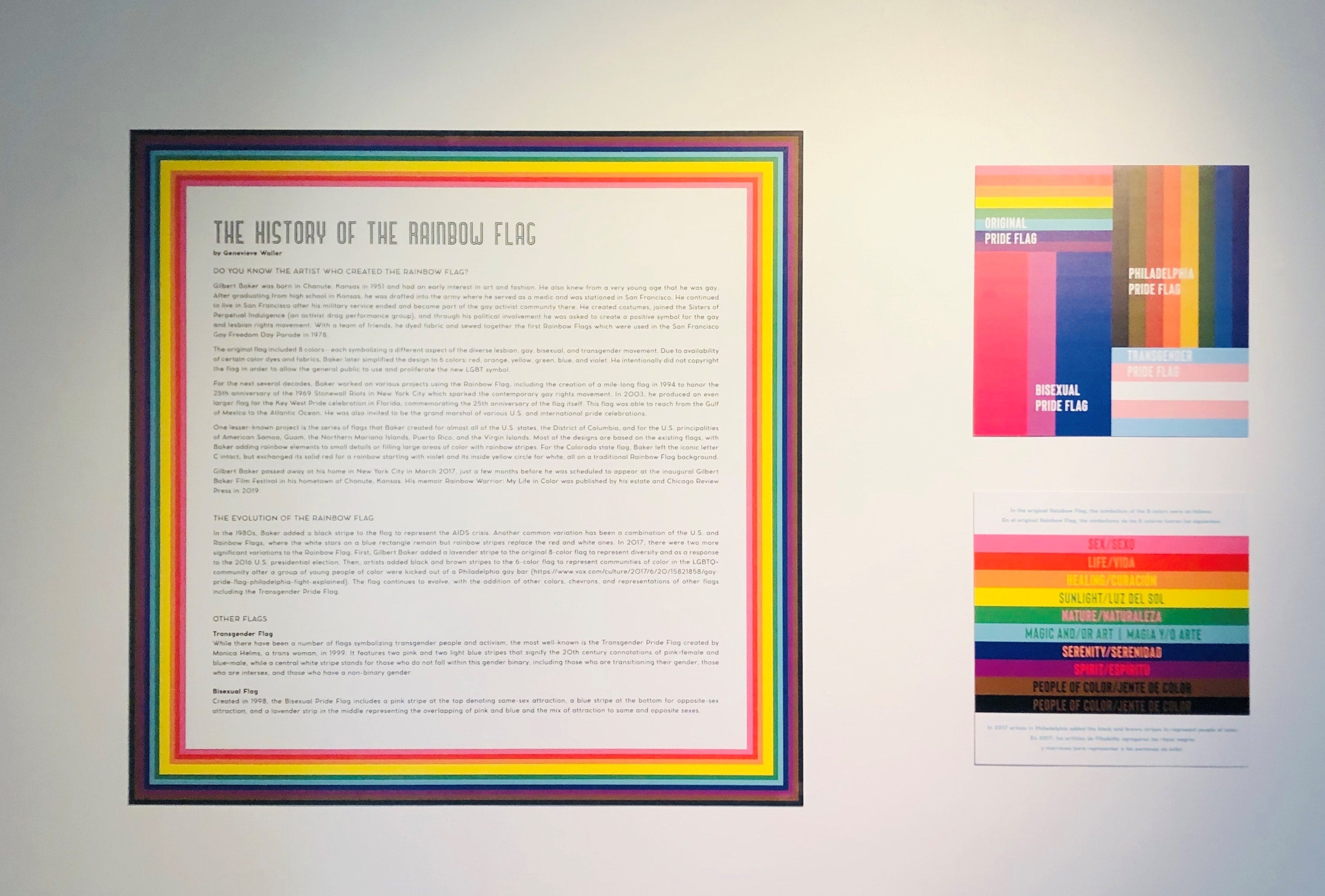programs
The History of the Rainbow Flag
05/30/2020 - 08/30/2020
The History of the Rainbow Flag by Genevieve Waller
Do you know the artist who created the rainbow flag?
Gilbert Baker was born in Chanute, Kansas in 1951 and had an early interest in art and fashion. He also knew from a very young age that he was gay. After graduating from high school in Kansas, he was drafted into the army where he served as a medic and was stationed in San Francisco. He continued to live in San Francisco after his military service ended and became part of the gay activist community there. He created costumes, joined the Sisters of Perpetual Indulgence (an activist drag performance group), and through his political involvement he was asked to create a positive symbol for the gay and lesbian rights movement. With a team of friends, he dyed fabric and sewed together the first Rainbow Flags which were used in the San Francisco Gay Freedom Day Parade in 1978.
The original flag included 8 colors—each symbolizing a different aspect of the diverse lesbian, gay, bisexual, and transgender movement. Due to availability of certain color dyes and fabrics, Baker later simplified the design to 6 colors: red, orange, yellow, green, blue, and violet. He intentionally did not copyright the flag in order to allow the general public to use and proliferate the new LGBT symbol.
For the next several decades, Baker worked on various projects using the Rainbow Flag, including the creation of a mile-long flag in 1994 to honor the 25th anniversary of the 1969 Stonewall Riots in New York City which sparked the contemporary gay rights movement. In 2003, he produced an even larger flag for the Key West Pride celebration in Florida, commemorating the 25th anniversary of the flag itself. This flag was able to reach from the Gulf of Mexico to the Atlantic Ocean. He was also invited to be the grand marshal of various U.S. and international pride celebrations.
One lesser-known project is the series of flags that Baker created for almost all of the U.S. states, the District of Columbia, and for the U.S. principalities of American Samoa, Guam, the Northern Mariana Islands, Puerto Rico, and the Virgin Islands. Most of the designs are based on the existing flags, with Baker adding rainbow elements to small details or filling large areas of color with rainbow stripes. For the Colorado state flag, Baker left the iconic letter C intact, but exchanged its solid red for a rainbow starting with violet and its inside yellow circle for white, all on a traditional Rainbow Flag background.
Gilbert Baker passed away at his home in New York City in March 2017, just a few months before he was scheduled to appear at the inaugural Gilbert Baker Film Festival in his hometown of Chanute, Kansas. His memoir Rainbow Warrior: My Life in Color was published by his estate and Chicago Review Press in 2019.
The Evolution of the Rainbow Flag
In the original Rainbow Flag, the symbolism of the 8 colors were as follows:
Hot Pink = Sex
Red = Life
Orange = Healing
Yellow = Sunlight
Green = Nature
Turquoise = Magic and/or Art
Indigo = Serenity
Violet = Spirit
In the 1980s, Baker added a black stripe to the flag to represent the AIDS crisis. Another common variation has been a combination of the U.S. and Rainbow Flags, where the white stars on a blue rectangle remain but rainbow stripes replace the red and white ones. In 2017, there were two more significant variations to the Rainbow Flag. First, Gilbert Baker added a lavender stripe to the original 8-color flag to represent diversity and as a response to the 2016 U.S. presidential election. Then, artists added black and brown stripes to the 6-color flag to represent communities of color in the LGBTQ+ community after a group of young people of color were kicked out of a Philadelphia gay bar (https://www.vox.com/culture/2017/6/20/15821858/gay-pride-flag-philadelphia-fight-explained).
The flag continues to evolve, with the addition of other colors, chevrons, and representations of other flags including the Transgender Pride Flag.
Other Flags
Transgender Flag
While there have been a number of flags symbolizing transgender people and activism, the most well-known is the Transgender Pride Flag created by Monica Helms, a trans woman, in 1999. It features two pink and two light blue stripes that signify the 20th century connotations of pink=female and blue=male, while a central white stripe stands for those who do not fall within this gender binary, including those who are transitioning their gender, those who are intersex, and those who have a non-binary gender.
Bisexual Flag
Created in 1998, the Bisexual Pride Flag includes a pink stripe at the top denoting same-sex attraction, a blue stripe at the bottom for opposite-sex attraction, and a lavender strip in the middle representing the overlapping of pink and blue and the mix of attraction to same and opposite sexes.
La historia de la Bandera Arco Iris de Genevieve Waller
¿Conoces al artista que creó la Bandera Arco Iris?
Gilbert Baker nació en Chanute, Kansas en 1951 y tuvo un temprano interés en el arte y la moda. También supo desde muy joven que era gay. Después de graduarse de la escuela secundaria en Kansas, fue reclutado por el Ejército de Estados Unidos y se desempeñó como médico, estacionado en San Francisco. Continuó viviendo en San Francisco después de que terminó su servicio militar y se convirtió en parte de la comunidad de activistas gay. Creó disfraces, se unió a las Hermanas de la Indulgencia Perpetua (un grupo de activistas y artistas drag) y, a través de su participación política, se le pidió que creara un símbolo positivo para el movimiento de los derechos de los gays y las lesbianas. Con un equipo de amigos, tiñó telas y cosió las primeras banderas arco iris que se usaron en el desfile del Día de la Libertad Gay de San Francisco en 1978.
La bandera original incluía ocho colores, cada uno simbolizando un aspecto diferente de los diversos movimientos de lesbianas, gays, bisexuales y transgénero. Debido a la disponibilidad de ciertos tintes y telas de colores, Baker luego simplificó el diseño a 6 colores: rojo, naranja, amarillo, verde, azul y violeta. Intencionalmente no buscó derechos de propiedad intelectual para su bandera, para permitir que el público en general la usase, proliferando así el nuevo símbolo LGBT.
Durante las siguientes décadas, Baker trabajó en varios proyectos utilizando la Bandera Arco Iris, incluida la creación de una bandera de una milla de largo en 1994 para honrar el 25º aniversario de los disturbios de Stonewall en 1969 en la ciudad de Nueva York, el incidente que dio origen al movimiento contemporáneo de los derechos de los gays. En 2003, produjo una bandera aún más grande para la Celebración del Orgullo de Key West en Florida, en conmemoración del 25º aniversario de la creación de la bandera. Esta bandera llegó desde el Golfo de México hasta el Océano Atlántico. También fue invitado a ser el “gran mariscal” de varias celebraciones nacionales e internacionales del orgullo gay.
Un proyecto menos conocido es la serie de banderas que Baker creó para casi todos los estados de EEUU, el Distrito de Columbia y para los territorios estadounidenses de Samoa Americana, Guam, las Islas Marianas del Norte, Puerto Rico y las Islas Vírgenes. La mayoría de los diseños se basan en las banderas existentes, con Baker agregando elementos del arco iris a pequeños detalles o rellenando grandes áreas de color con rayas del arco iris. Para la bandera del estado de Colorado, Baker dejó intacta la icónica letra C, pero cambió su rojo sólido por un arcoíris que comienza con violeta y su círculo amarillo interior por blanco, todo sobre un fondo tradicional de la Bandera Arco Iris.
Gilbert Baker falleció en su hogar en la Ciudad de Nueva York en marzo de 2017, solo unos meses antes de que fuera programado para aparecer en el primer Festival de Cine “Gilbert Baker” en su ciudad natal de Chanute, Kansas. Sus memorias. Rainbow Warrior: My Life in Color. fueron publicadas por sus herederos y por Chicago Review Press en 2019.
La evolución de la Bandera Arco Iris
En la bandera original, esto es lo que representaba cada color simbólico:
Rosa intenso = Sexo
Rojo = Vida
Naranja = Sanidad
Amarillo = Luz del sol
Verde = Naturaleza
Turquesa = Magia o arte
Índigo = Serenidad
Violeta = Espíritu
En la década de 1980, Baker agregó una franja negra a la bandera para representar la crisis del SIDA. Otra variación común ha sido una combinación de las banderas de EE UU la Bandera Arco Iris, donde las estrellas blancas en un rectángulo azul permanecen, pero las rayas del arco iris reemplazan a las rojas y blancas. En 2017, hubo dos variaciones más significativas a la Bandera Arco Iris. Primero, Gilbert Baker agregó una franja de lavanda a la bandera original de 8 colores para representar la diversidad y como respuesta a las elecciones presidenciales de 2016 en Estados Unidos. Luego, los artistas agregaron rayas negras y marrones a la bandera de 6 colores para representar a las comunidades de color en la comunidad LGBTQ + después de que un grupo de jóvenes de color fuera expulsado de un bar gay de Filadelfia (https://www.vox.com/culture/2017/6/20/15821858/gay-pride-flag-philadelphia-fight-explained).
La bandera continúa evolucionando, con la adición de otros colores, símbolos y representaciones de otras banderas, incluida la Bandera del Orgullo Transgénero.
Otras banderas
Bandera trasgénero
Si bien ha habido una serie de banderas que simbolizan a las personas transgénero y su activismo, la más conocida es la Bandera del Orgullo Transgénero creada por Mónica Helms, una mujer trans, en 1999. Cuenta con dos franjas rosas y dos celestes que representan connotaciones propias del siglo 20: rosa = femenino y azul = masculino, mientras que una franja blanca central representa a aquellos que no entran en ese género binario, incluidos aquellos que están en transición de género, aquellos que son intersexuales y aquellos que tienen un género no binario.
Bandera bisexual
Creada en 1998, la Bandera del Orgullo Bisexual incluye una franja rosa en la parte superior que indica atracción hacia el mismo sexo, una franja azul en la parte inferior para la atracción del sexo opuesto y una franja de lavanda en el medio que representa la superposición de rosa y azul y la mezcla. de atracción a los mismos y opuestos sexos.

